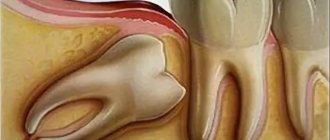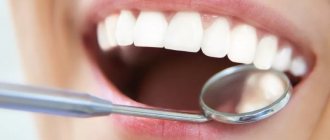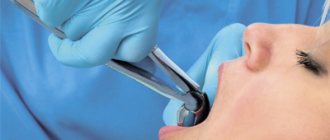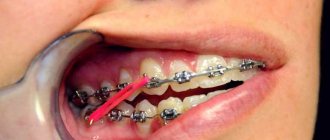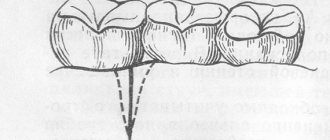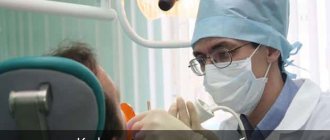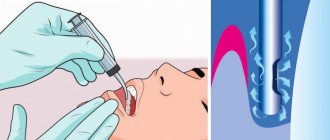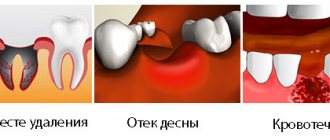Content:
- What to do before deleting the eight
- What happens in the oral cavity during the extraction of the eighth tooth?
- What to do after wisdom tooth removal 3.1. The first day after removal 3.2. Second day after pulling out figure eight 3.3. Third and fourth days after wisdom tooth removal 3.4. A week after wisdom tooth removal 3.5. A month later
After a wisdom tooth is removed, the socket often becomes infected. Because of this, severe swelling forms and the tissues become inflamed. To exclude the development of negative complications, you need to properly prepare for surgery and follow all medical recommendations after it.
Teething
Cholisal gel is not recommended for teething children - it causes excessive salivation. The product contains anise, which affects infants differently than adults. Excessive salivation will cause irritation on the child's chin.
For older children, the gel can be used, for example, when replacing baby teeth with permanent ones. Before use, you need to sanitize the child’s oral cavity, dry the inflamed gums with a cotton swab and rub the product into the mucous membrane with gentle movements (in a circular motion).
At what age can children use the gel? Doctors believe that after a year it is already possible to treat a child’s gums with Cholisal. However, the later you apply it, the better. This is due specifically to uncontrolled salivation. The baby may simply choke on his own saliva, and this is dangerous.
The modern pharmaceutical industry offers a wide selection of children's medications for stomatitis and inflammation of the gum mucosa; it is better to use them. For example, Kamistad has proven itself well for children. However, be careful with drugs containing anesthetics: they reduce sensitivity and the child may bite the tongue or lose control of the swallowing reflex and choke on saliva.
Another contraindication to the use of Cholisal for children is the salicylic acid contained in the composition. This acid is aggressive towards tooth enamel, which is especially sensitive in children. The baby's enamel coating may become thinner, and he will feel pain from hot/cold food. Salicylic acid effectively destroys germs and cleanses the oral cavity, but a side effect is the destruction of the enamel layer.
What to do before deleting the eight
There are a number of rules to make surgery safer and reduce the risk of postoperative complications. Among them:
- Eat one to three hours before visiting the dentist (but if general anesthesia is planned, you cannot eat!). A preliminary meal before extraction, performed under local anesthesia, promotes better blood clotting and improves the patient’s physical condition.
- Carry out removal in the first half of the day (preferably in the morning). In the morning hours, the human body copes better with stressful situations. In addition, if the procedure is scheduled for the evening, the patient may experience insomnia due to persistent pain and nervous tension.
- Do not drink alcoholic beverages on the eve of surgery. They negatively affect the rheological properties of blood, which means that the risk of swelling and bleeding will increase.
- In case of severe anxiety, take a sedative of herbal origin. It is important that the person is not allergic to the drug used.
To remove the figure eight, you need to choose a clinic and a dental surgeon whose reputation is beyond doubt. Then the patient will be able to relax better, which means the procedure will be more comfortable.
Types of seams. Types of threads
In each case, when the dental surgeon sutures the gum, he decides which suture to use.
Seams can be intermittent or continuous.
The first type is more common and is characterized by the overlapping of separate, unrelated stitches (pictured below), and each is secured with its own knot.
This maintains the integrity of the fabrics, even if one of the stitches fails and falls off.
There is continuous suturing. All stitches are made with a single suture thread, securing them with a common knot. It's faster, but any damage to one stitch can ruin the entire thread construction.
Absorbable and non-absorbable threads are used to suture the gums.
Sutures that dissolve
Natural (Catgut) and synthetic (Vicryl, Dexon) threads are used. When suturing the gums with Catgut, it can stay on the wound for at least 2 weeks. It is dissolved by saliva substances, but due to its protein base it often causes allergies with inflammation of the gums.
Catgut is contraindicated if there is a high risk of inflammatory complications. Dental surgeons are using this material less and less.
Synthetic Vicryl is safe in terms of tolerability, adheres tightly to the gum, and does not change its strength properties during disinfection. If the doctor does not prescribe a time limit for removing the threads, they will still dissolve within 3 months.
Dexon will last on the gums a little longer than Vicryl, otherwise their properties are similar.
No one can say for sure how long it takes for threads to dissolve in a particular patient. This depends on individual factors: characteristics of the wound, the chemical environment of the oral cavity, general immunity, and the patient’s hormonal status.
When absorbed, the thread does not disappear without a trace, but gradually disintegrates into particles, which are spat out or swallowed by the patient. It is not dangerous to health.
Threads that do not dissolve
Non-absorbable threads are nylon, silk, polyamide fiber (nylon). Synthetic threads are completely hypoallergenic.
Sutures made from non-absorbable sutures are called non-absorbable or non-absorbable sutures. Their removal after the stitches have healed is mandatory. If such threads are used and there are no complications, the surgeon will release the patient from them 7–10 days after the tooth has been pulled out or another operation on the gums has been performed.
What happens in the oral cavity during the extraction of the eighth tooth?
When deciding how to treat a particular patient, the doctor takes into account the characteristics of his physical and emotional state. Particular attention is paid to the presence of allergies to medications.
If there are no contraindications to extraction, the doctor administers an anesthetic. When the area becomes insensitive, the gum bends back and grabs the wisdom tooth with forceps. Begins to make rocking movements, allowing you to loosen the periodontal connection and extract the diseased tooth.
Since during the operation the vessels through which blood flows to the pulp tissues are damaged, bleeding occurs. Nerve impulses indicating trauma are transmitted to the brain. Then pain appears. But due to the action of the anesthetic, the patient does not feel it at first.
The hole formed as a result of the operation is heavily supplied with blood. Leukocytes rush here. Swelling occurs and inflammation develops.
Immediately after surgery, the doctor closes the wound with a sterile cotton swab. It helps stop bleeding and creates conditions for the formation of a dense blood clot. The latter is needed to prevent the penetration of pathogenic microorganisms into the tissues of the wound surface. Do not remove the tampon before the doctor says!
Mode of application
It is useless to use Cholisal before visiting a doctor and removing plaque and deposits from your teeth. If you fail to comply with this requirement, you risk the disease becoming chronic, although it does not show any symptoms. It should be noted that this is much more dangerous and can lead to tooth loss.
Following the instructions for use, Cholisal is used for 10 days. It is recommended to carry out the procedure in the morning, after eating and brushing your teeth and before going to bed. Before use, rinse your mouth with Chlorhexidine or a composition based on it. For adults, the dose is 1 cm of gel, for children it is half as much.
For periodontal diseases, you should lubricate the gums with gel or apply it in the form of compresses a couple of times a day.
How to use Cholisal gum gel correctly is written in the instructions. We must immediately warn you that it is impossible to cure dental diseases with gel - it is used in an integrated approach to healing. Usually, medications with antiseptic and other effects are prescribed along with it.
It is important to understand that it is impossible to eliminate inflammatory processes in the soft tissues of the gums in the presence of dense plaque on the teeth and tartar. The plaque layer contains pathogenic bacteria, which are the source of inflammatory formations.
The use of gel for tartar is dangerous, since only visible foci of inflammation are eliminated. The person calms down that the disease has passed - but the inflammation remains inside the soft tissues. As a result, the infection will begin to destroy bone tissue, which threatens the loosening and loss of healthy teeth.
Brief instructions:
- rinse your mouth with chlorhexidine after eating;
- dry the gums with a cotton or gauze swab for better absorption of the gel;
- apply the substance to the inner and outer edges of the gums and papillae;
- After applying the gel, you should not drink for 30 minutes and eat for 2 hours.
What is the best way to apply Cholisal gel? For this purpose, the pharmacy sells special medical spatulas. The product is used after sleep and before bedtime for ten days. It is important not to miss a single day.
What to do after wisdom tooth removal
The eighth units, located on the upper jaw, are removed less painfully. The lower jaw bone is denser. It includes an extensive root system. Therefore, the lower eights are usually more difficult to pull out.
To avoid problems during regeneration, you should properly care for the hole. The most important thing is to prevent the proliferation of pathogenic microorganisms inside it. After removing the 8th tooth, you should never:
- make suction movements from the hole (they lead to detachment of the blood clot);
- chew food on the side where the wound is located;
- rinse the hole intensively with antiseptics;
- take medications that were not prescribed by a doctor.
The first day after removal
After about half an hour, you are allowed to remove the tampon covering the wound. It is important to do this exactly when the doctor who performed the operation tells you to.
In case of severe pain, you are allowed to take a painkiller. Doctors usually recommend non-steroidal anti-inflammatory drugs based on nimesulide.
In the first three hours after extraction, you should not eat anything or drink hot drinks. It is important to exclude active facial expressions, as this may cause bleeding. It is advisable to sleep on the side of the extracted tooth.
Second day after pulling out the figure eight
The patient is bothered by pain. Body temperature may rise to 38 degrees. To reduce discomfort, you can take NSAIDs and apply cold compresses.
On the second day after surgery, it is advisable to eat soft foods - porridge, soups, broths. Food must be warm and at room temperature. Never cold or hot. The patient will have to give up spicy, sweet, very salty and sour foods.
You should take medications prescribed by your dentist. Rinsing is not recommended, as it may help flush out the blood clot.
Third and fourth days after wisdom tooth removal
These days, granulation tissue begins to actively form. It is from this that new epithelium is formed in the future. As prescribed by the doctor, the patient can rinse with antiseptics.
Typically, pain decreases at this stage of regeneration, so there is no need to take analgesics or NSAIDs.
One week after wisdom tooth removal
Seven days after surgery to remove a wisdom tooth, the socket is completely covered with new connective tissue. A healthy epithelium forms on its surface. If the body temperature does not increase, the swelling has passed, which means that healing is proceeding without complications.
The patient still needs to abstain from eating solid foods. Food should not be cold or hot. It is important to take good care of your mouth and not skip routine dental checkups.
Leukoplakia
This disease is characterized by a special condition, which, as a rule, appears immediately before the development of oncology. In this case, leukoplakia can manifest itself not only as very severe itching in the gum area. Other symptoms also occur: a feeling of numbness, white spots and a dense coating form on the affected area of the gums or oral cavity. Almost all patients suffering from leukoplakia complain about this. In most cases, the disease affects people who have a long history of smoking and smoke more than a pack of cigarettes per day.
Bottom line
Cholisal gel is used for dental problems in the oral cavity - inflammatory processes, stomatitis, periodontitis and disruption of the integrity of the mucous membrane. The gel is safe and is sold without a prescription, however, independent use of any medication is dangerous due to unpredictable consequences. Therefore, any treatment must be coordinated with a doctor.
Is it possible to use Cholisal for stomatitis in children? Theoretically, it is possible, and the instructions allow the use of the drug to cure the disease. However, salicylic acid, which is part of the composition, has a negative effect on the enamel - it thins it. This can cause carious lesions and discomfort when eating. Therefore, it is better to replace Cholisal with another drug that does not contain salicylates and lidocaine.
Why does it hurt
The most obvious reason is the body’s natural physiological response to surgical trauma. All third molars - wisdom teeth - are large and have 2-5 roots. After their extraction, an open bleeding wound remains in the gum tissue and jawbone, caused by damage to the connections between the tissues.
The wound is filled with a blood clot - it is this that prevents infection from entering the hole and serves as the basis for the formation of granulation tissue - connective material that will fill the space formed after the removal of the 8. In the meantime, the hole remains injured, you may be worried about increased body temperature (within 37-37.5 degrees) and pain.
Normally, these symptoms gradually disappear within a week. But only with proper care.
Why does the tooth under a filling itch?
After applying the filling material, individual intolerance sometimes occurs. In addition, allergic reactions appear, expressed by redness, swelling, and itching. If the symptom does not go away or gets worse, it is important to see a dentist as soon as possible.
When dental treatment is not performed correctly (for example, not all of the carious area is removed), over time the affected tissues begin to rot and decompose, causing infection. If discomfort appears, a complete replacement of the filling is indicated. If pathogenic microorganisms have managed to penetrate the pulp by this time, you cannot avoid depulpation.
Possible complications
Delay in seeking professional help and lack of treatment measures in the event of phlegmon threatens the rapid development and progression of the inflammatory process. This is fraught with the following complications:
- respiratory tract infection;
- asphyxia;
- meningitis;
- blood poisoning;
- thrombosis of facial veins.
Prolonged neglect of phlegmon over time can lead to irreversible pathological changes in the body, which can lead to disability and death.
Reviews
Oral phlegmon is a severe and rapidly progressing inflammatory and purulent process that requires immediate professional medical care.
Experts recommend that at the slightest sign of inflammation, contact a dental center and not neglect regular examination and sanitation of the oral cavity.
If you have experience dealing with dental phlegmon, share your knowledge in the comments section of the article.
If you find an error, please select a piece of text and press Ctrl+Enter.
Tags: tooth phlegmon
Did you like the article? stay tuned
Diagnostic measures
Often, to identify phlegmon, the dentist only needs an external examination of the patient and collection of complaints.
However, to determine the exact location of the source of inflammation and the extent of its spread throughout the tissues of the oral cavity, additional diagnostic methods are required - computed tomography and ultrasound.
To clarify the severity of the inflammatory process, a general blood test is prescribed, and to determine the causative agent of the disease, culture of purulent contents is performed .
Using this analysis, the sensitivity of pathogenic microflora to various antibiotics is subsequently studied.
How to rinse
To protect the wound from infection, rinse your mouth with traditional or traditional medicine:
- Chlorhexidine;
- Stomatidine;
- Miramistin;
- Rivanol;
- Furacilin;
- decoctions of chamomile and calendula flowers, sage, oak bark.
You cannot start rinsing earlier than a day later. This is fraught with early loss of blood clot. Rinsing should also not be too active; it is better to do antiseptic baths - take the solution into your mouth, tilt your head briefly to the side of the sore spot, then spit.
Rinse solutions are prepared cool, since bacteria begin to actively multiply in a warm, humid environment. Alcohol-based products are not suitable for rinsing; they can cause gum burns.
Read how and what to rinse your mouth with for quick healing after tooth extraction.
